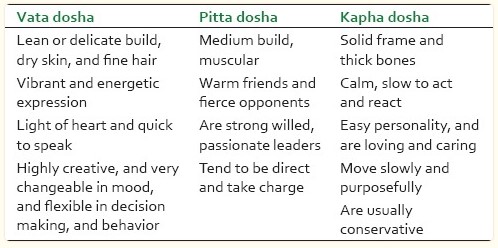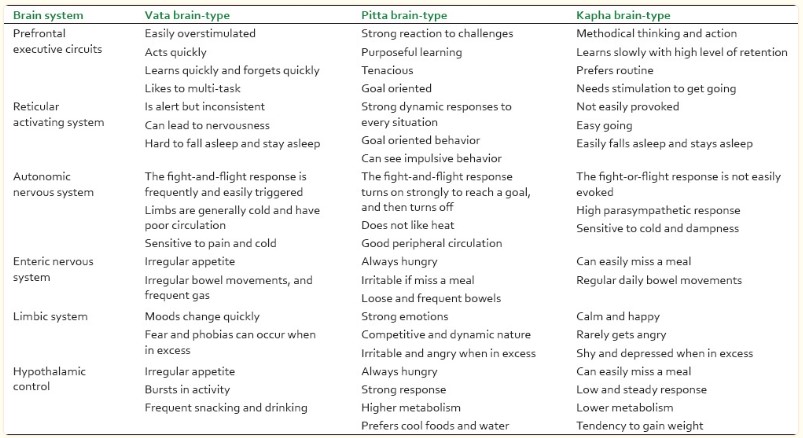The connection between yoga’s three doshas (pita, vata, and kapha) and the “Big Five” personality trait model is not a direct one, as the two systems are based on different philosophies and approaches to understanding human personality. However, some common themes and correspondences can be drawn between the two frameworks.
The three Doshas

In yoga philosophy, the doshas are believed to be the three fundamental energies or forces that govern the functioning of the body and mind. Each person is thought to have a unique balance of the doshas, which can influence their physical and psychological characteristics.
Pita is associated with the elements of fire and water, and is thought to be responsible for metabolism, digestion, and heat in the body. People with a predominance of pita are often described as energetic, ambitious, and driven, but may also be prone to anger and irritation if out of balance.
Vata is associated with the elements of air and ether, and is thought to govern movement and communication in the body. People with a predominance of vata are often described as creative, flexible, and quick-witted, but may also be prone to anxiety and instability if out of balance.
Kapha is associated with the elements of earth and water, and is thought to govern structure and stability in the body. People with a predominance of kapha are often described as calm, stable, and grounded, but may also be prone to sluggishness and attachment if out of balance.
Some research was done on three dosha brain types

The “Big Five” model
The “Big Five” personality trait model, on the other hand, is a widely-used psychological framework for understanding personality. It identifies five broad dimensions of personality:
- Openness
- Conscientiousness
- Agreeableness
- Neuroticism
- Extroversion
Openness refers to a person’s openness to new experiences and ideas, and is characterized by traits such as creativity, curiosity, and open-mindedness. Conscientiousness refers to a person’s level of organization, responsibility, and dependability, and is characterized by traits such as reliability and self-discipline. Agreeableness refers to a person’s tendency to be cooperative and considerate of others, and is characterized by traits such as kindness and generosity. Neuroticism refers to a person’s tendency to experience negative emotions such as anxiety and sadness, and is characterized by traits such as emotional instability and sensitivity. Extroversion refers to a person’s tendency to be sociable and outgoing, and is characterized by traits such as assertiveness and confidence.
High Pita, High Openness, High Extroversion
Pita is generally associated with qualities such as energy, ambition, and drive, which may overlap with traits such as conscientiousness and extroversion in the “Big Five” model. Vata is generally associated with qualities such as creativity, flexibility, and quick-wittedness, which may overlap with traits such as openness and extroversion in the “Big Five” model. Kapha is generally associated with qualities such as calmness, stability, and groundedness, which may overlap with traits such as agreeableness and conscientiousness in the “Big Five” model.
Low Kapha low Agreeableness and Conscientiousness
Low levels of kapha (or low agreeableness and conscientiousness) might be associated with qualities such as independence, competitiveness, and self-interest. People with low levels of agreeableness might be more independent and self-directed, and less concerned with maintaining harmony and pleasing others. They might also be more competitive and assertive in pursuing their goals. Similarly, people with low levels of conscientiousness might be less organized, reliable, responsible, and more prone to taking risks and making impulsive decisions.
In summary, while the yoga doshas and the “Big Five” personality trait model are based on different approaches to understanding personality, there are some common themes and correspondences that can be drawn between the two frameworks.
It’s important to note that these associations are generalizations, and individual differences in personality are complex and multi-dimensional. It’s also important to remember that the “Big Five” personality trait model is a psychological framework, while the yoga doshas are a philosophical system with a different set of assumptions and concepts. The two frameworks should not be seen as equivalent or interchangeable.
What type of yoga would most likely “high conscientiousness” people prefer?
Predict what type of yoga an individual with high conscientiousness will prefer, as personal preferences and individual differences play a significant role in determining what type of yoga a person might enjoy. However, some people with high conscientiousness may prefer yoga styles that are structured, disciplined, and goal-oriented, as these qualities align with their personality.
Here are a few yoga styles that might be particularly appealing to people with high conscientiousness:
Hatha yoga: Hatha yoga is a traditional form of yoga that emphasizes physical postures (asanas), breath control (pranayama), and meditation. It is a relatively slow-paced and structured style of yoga, and may appeal to people with high conscientiousness who prefer a more disciplined and methodical approach to their practice.
Vinyasa yoga: Vinyasa yoga is a dynamic style of yoga that involves flowing from one posture to the next in a sequence, synchronizing the breath with the movements. It is a more active and physically challenging style of yoga, and may appeal to people with high conscientiousness who enjoy setting and working towards goals.
Ashtanga yoga: Ashtanga yoga is a physically demanding style of yoga that follows a specific sequence of postures, with an emphasis on alignment and breath control. It is a highly structured and disciplined practice, and may appeal to people with high conscientiousness who enjoy a structured and challenging workout.
It’s important to keep in mind that these are just a few examples, and there are many other styles of yoga that might also be enjoyable for people with high conscientiousness. Ultimately, the most important thing is to find a practice that resonates with you personally and meets your individual needs and preferences.

